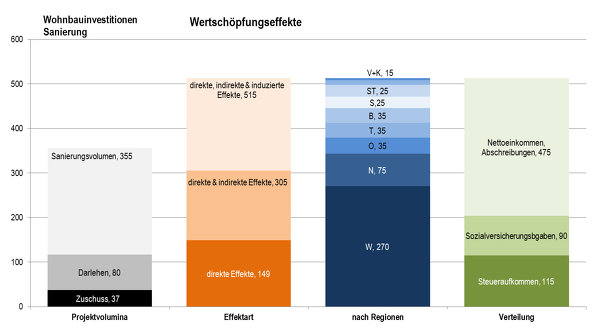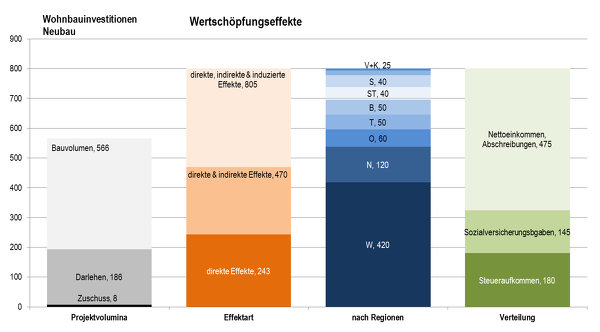Economic Effects of Subsidised Residential Construction in Vienna 2010-2013
In the period from 2010 to 2013, the City of Vienna subsidized via the so called “Wiener Wohnbauförderung” the construction of 4,438 new housing units and the adaptation of 13,154 housing units per year on average, resulting in volumes of 565.7 mn € and 355.3 mn € for new construction and adaptation respectively. Subsidies were granted as a mix of loans and allowances. New construction projects received overwhelmingly loans (of about 179.2 mn €), compared to 7.7 mn € of allowances, whereas housing adaptations and improvements received 37.1 mn € in allowances and 79.7 mn € in the form of loans.
In 2012 and 2013, within a special programme called “Housing Initiative” (WBIWohnbauinitiative), the City of Vienna supported additionally 3,543 new housing units with a total construction volume of 484.6 mn €, by granting loans at a low interest rate as well as by providing properties at a benchmark price of 235 Euro per square meter rentable floorspace for purchase with equity capital.
The effect of these construction volumes on the value added of the Austrian construction sector is estimated at more than 240 mn € in the case of new housing and 150 mn € for the subsidized adaptations, providing 3,250 and 2,650 jobs respectively. With 7.7 employment relationships per 1 mn € project volume, adaptations are clearly more labour-intensive than new construction with 5.7 jobs.
Via both backward and forward economic linkages, the economic cycle gives rise to indirect and induced demand: indirect demand consists of intermediates, i.e. purchases of goods and services (to be used in the production process) by the firms which are directly involved in the construction works; induced demand is effected through final demand, which is mainly private consumption financed by wages and income generated by the direct and indirect effects and investment demand from firms which are directly and indirectly connected with the simulated project volumes. These are called “multiplier effects” which were estimated using an integrated regional Input-Output model of the Austrian economy (ASCANIO). ASCANIO models the sectoral and regional linkages between 58 industries, producing 58 commodities, in the 9 Austrian provinces (“Bundesländer”).
ASCANIO estimates the total value added effects – i.e. the sum of direct, indirect and induced effects on the Austrian economy – at 785 and 515 mn € for new housing and adaptations, respectively, providing the basis for 10,500 resp. 7,500 jobs. These numbers should be interpreted as “additional” or “new” jobs – rather, it is the number of jobs which is typically connected to the simulated valued added effects. Including the indirect and induced effects, the difference in labour intensity between new construction and adapatations becomes smaller (18.5 vs. 20.4 jobs per 1 mn € of construction volume).
At the regional level, the highest effects are estimated for Vienna, with a share of over 50%. Inter-regional linkages (the most important of which are inter-regional trade and commuting) make sure that virtually all 9 provinces share in the effects of Viennese housing construction, albeit to varying degrees (the neighbouring province of Lower Austria, which is also the largest province, is credited with 15% of the effects; on the other end of the spectrum, Vorarlberg and Carinthia, small provinces on the other side of Austria, receive only around 2% of the total effects).
The economic effects connected to subsidised housing projects give rise to taxes and social security contributions of about 300 and 235 mn € respectively. Because the regional distribution of taxes largely follows a pre-defined structure, Vienna’s share of total provincial and community-level taxes is much lower than its Value Added share, at around one quarter.
Summing up, the economic chain of effects of adaptations and new housing can be illustrated as follows:




The third programme that was investigated, the “Housing Initiative” (WBI-Wohnbauinitiative), with a project volume of 232 mn € on average in 2012 and 2013, is credited with a total effect on value added of 325 mn €, providing for around 4,300 jobs. Sectoral and fiscal structures are similar to the construction of new housing; however, because the WBI constitutes a type of funding which is fundamentally different from the “usual” funding in Vienna, we keep the results separate.
Two caveats apply: the effects as reported here cannot be related directly to the grants provided by Wiener Wohnbauförderung, as this paper did not inquire into the question of additionality (i.e., the affect of the subsidies on the total construction volume); accordingly, rather than “effects of the subsidy”, they have to be interpreted as “effects of subsidized construction work”. They are also “incomplete” with respect to (construction) work which is related to but not covered by the housing construction itself (for example, adaptations to infrastructure elements like sewage or transport systems). Similarly, “enabling” effects (like the positive effect on local living and business conditions brought about by the subsidized projects) are beyond the scope of this analysis.
In the period from 2010 to 2013, the City of Vienna subsidized via the so called “Wiener Wohnbauförderung” the construction of 4,438 new housing units and the adaptation of 13,154 housing units per year on average, resulting in volumes of 565.7 mn € and 355.3 mn € for new construction and adaptation respectively. Subsidies were granted as a mix of loans and allowances. New construction projects received overwhelmingly loans (of about 179.2 mn €), compared to 7.7 mn € of allowances, whereas housing adaptations and improvements received 37.1 mn € in allowances and 79.7 mn € in the form of loans.
In 2012 and 2013, within a special programme called “Housing Initiative” (WBIWohnbauinitiative), the City of Vienna supported additionally 3,543 new housing units with a total construction volume of 484.6 mn €, by granting loans at a low interest rate as well as by providing properties at a benchmark price of 235 Euro per square meter rentable floorspace for purchase with equity capital.
The effect of these construction volumes on the value added of the Austrian construction sector is estimated at more than 240 mn € in the case of new housing and 150 mn € for the subsidized adaptations, providing 3,250 and 2,650 jobs respectively. With 7.7 employment relationships per 1 mn € project volume, adaptations are clearly more labour-intensive than new construction with 5.7 jobs.
Via both backward and forward economic linkages, the economic cycle gives rise to indirect and induced demand: indirect demand consists of intermediates, i.e. purchases of goods and services (to be used in the production process) by the firms which are directly involved in the construction works; induced demand is effected through final demand, which is mainly private consumption financed by wages and income generated by the direct and indirect effects and investment demand from firms which are directly and indirectly connected with the simulated project volumes. These are called “multiplier effects” which were estimated using an integrated regional Input-Output model of the Austrian economy (ASCANIO). ASCANIO models the sectoral and regional linkages between 58 industries, producing 58 commodities, in the 9 Austrian provinces (“Bundesländer”).
ASCANIO estimates the total value added effects – i.e. the sum of direct, indirect and induced effects on the Austrian economy – at 785 and 515 mn € for new housing and adaptations, respectively, providing the basis for 10,500 resp. 7,500 jobs. These numbers should be interpreted as “additional” or “new” jobs – rather, it is the number of jobs which is typically connected to the simulated valued added effects. Including the indirect and induced effects, the difference in labour intensity between new construction and adapatations becomes smaller (18.5 vs. 20.4 jobs per 1 mn € of construction volume).
At the regional level, the highest effects are estimated for Vienna, with a share of over 50%. Inter-regional linkages (the most important of which are inter-regional trade and commuting) make sure that virtually all 9 provinces share in the effects of Viennese housing construction, albeit to varying degrees (the neighbouring province of Lower Austria, which is also the largest province, is credited with 15% of the effects; on the other end of the spectrum, Vorarlberg and Carinthia, small provinces on the other side of Austria, receive only around 2% of the total effects).
The economic effects connected to subsidised housing projects give rise to taxes and social security contributions of about 300 and 235 mn € respectively. Because the regional distribution of taxes largely follows a pre-defined structure, Vienna’s share of total provincial and community-level taxes is much lower than its Value Added share, at around one quarter.
Summing up, the economic chain of effects of adaptations and new housing can be illustrated as follows:


The third programme that was investigated, the “Housing Initiative” (WBI-Wohnbauinitiative), with a project volume of 232 mn € on average in 2012 and 2013, is credited with a total effect on value added of 325 mn €, providing for around 4,300 jobs. Sectoral and fiscal structures are similar to the construction of new housing; however, because the WBI constitutes a type of funding which is fundamentally different from the “usual” funding in Vienna, we keep the results separate.
Two caveats apply: the effects as reported here cannot be related directly to the grants provided by Wiener Wohnbauförderung, as this paper did not inquire into the question of additionality (i.e., the affect of the subsidies on the total construction volume); accordingly, rather than “effects of the subsidy”, they have to be interpreted as “effects of subsidized construction work”. They are also “incomplete” with respect to (construction) work which is related to but not covered by the housing construction itself (for example, adaptations to infrastructure elements like sewage or transport systems). Similarly, “enabling” effects (like the positive effect on local living and business conditions brought about by the subsidized projects) are beyond the scope of this analysis.
Facts
- Project Management
WIFO Austrian Institute of Economic Research - Project Team
Gerhard Streicher
Michael Weingärtler - Duration
2014 - Contacts
Gerhard.Streicher[at]wifo.ac.at
Michael.Weingaertler[at]wifo.ac.at - Downloads Abstract (German) 827.9 KB
Abstract (English) 908.77 KB
Report (German) 5.19 MB

